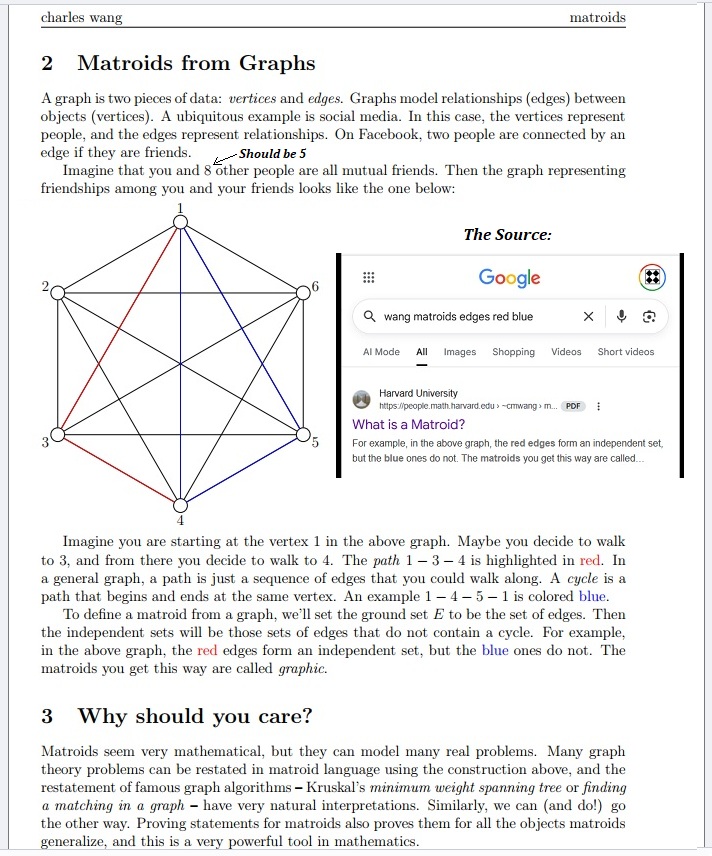"Hieronymus, Harry … Harry, Hieronymus."
"Another opening, another show."
Or… "Mathematics for Language Animals: A Unifying Framework"

Also on November 11, 2005, a figure from this journal —

Students of myth may regard this hexagonal figure as a
snowflake . . . or, with a seventh dot added at the center,
a cube. For a religious interpretation of the snowflake,
see Thomas Mann's novel The Magic Mountain. For a
more secular, but still miraculous, interpretation of the
cube, see the oeuvre of R. T. Curtis . . . and Octad Space —
"Before time began . . . ." — Optimus Prime
From Wikipedia's Iceberg Theory —

Related material:
The Eightfold Cube and The Quantum Identity —
See also the previous post.
Key
Today is Joan Didion's birthday. It is also the date that the first Phi Beta Kappa chapter was formed, at the College of William and Mary.
A reading for today, from a web page called Respect:
"In her book Slouching Toward Bethlehem Didion writes about being a student in college. She says she expected to be voted into Phi Beta Kappa but discovered she didn't have the grades for it. She says: 'I had somehow thought myself [as being] exempt from the cause-effect relationships which hampered others.' But, Didion continues:
Although even the humorless nineteen-year-old that I was must have recognized that the situation lacked tragic stature, the day that I did not make Phi Beta Kappa nonetheless marked the end of something, and innocence may well be the word for it. I lost the conviction that lights would always turn green for me, the pleasant certainty that those rather passive virtues which had won me approval as a child automatically guaranteed me not only Phi Beta Kappa keys but happiness, honor, and the love of a good man. I lost a certain touching faith in the totem power of good manners, clean hair, and proven competence on the Stanford-Binet scale. To such doubtful amulets had my self-respect been pinned, and I faced myself that day with the nonplused apprehension of someone who has come across a vampire and has no crucifix in hand.
What Joan Didion discovered in the wake of this incident was that self-respect, although it was of importance, had to come from something inside her, rather than from the approval of others. She says she learned that self-respect has to do with 'a separate peace, a private reconciliation,' and at the heart of it is a willingness to accept responsibility for one's own life, whatever its rewards or lack of them. Didion says:
… people with self-respect have the courage of their mistakes. They know the price of things…. People with self-respect exhibit a certain toughness, a kind of moral nerve; they display what was once called character, a quality which, although approved in the abstract, sometimes loses ground to other, more instantly negotiable virtues.
— Comments by David Sammons
For more of Didion's essay, click here.
Sacerdotal Jargon
From the website
Abstracts and Preprints in Clifford Algebra [1996, Oct 8]:
Paper: clf-alg/good9601
From: David M. Goodmanson
Address: 2725 68th Avenue S.E., Mercer Island, Washington 98040
Title: A graphical representation of the Dirac Algebra
Abstract: The elements of the Dirac algebra are represented by sixteen 4×4 gamma matrices, each pair of which either commute or anticommute. This paper demonstrates a correspondence between the gamma matrices and the complete graph on six points, a correspondence that provides a visual picture of the structure of the Dirac algebra. The graph shows all commutation and anticommutation relations, and can be used to illustrate the structure of subalgebras and equivalence classes and the effect of similarity transformations….
Published: Am. J. Phys. 64, 870-880 (1996)
The following is a picture of K6, the complete graph on six points. It may be used to illustrate various concepts in finite geometry as well as the properties of Dirac matrices described above.

From
"The Relations between Poetry and Painting,"
by Wallace Stevens:
"The theory of poetry, that is to say, the total of the theories of poetry, often seems to become in time a mystical theology or, more simply, a mystique. The reason for this must by now be clear. The reason is the same reason why the pictures in a museum of modern art often seem to become in time a mystical aesthetic, a prodigious search of appearance, as if to find a way of saying and of establishing that all things, whether below or above appearance, are one and that it is only through reality, in which they are reflected or, it may be, joined together, that we can reach them. Under such stress, reality changes from substance to subtlety, a subtlety in which it was natural for Cézanne to say: 'I see planes bestriding each other and sometimes straight lines seem to me to fall' or 'Planes in color. . . . The colored area where shimmer the souls of the planes, in the blaze of the kindled prism, the meeting of planes in the sunlight.' The conversion of our Lumpenwelt went far beyond this. It was from the point of view of another subtlety that Klee could write: 'But he is one chosen that today comes near to the secret places where original law fosters all evolution. And what artist would not establish himself there where the organic center of all movement in time and space—which he calls the mind or heart of creation— determines every function.' Conceding that this sounds a bit like sacerdotal jargon, that is not too much to allow to those that have helped to create a new reality, a modern reality, since what has been created is nothing less."
Powered by WordPress